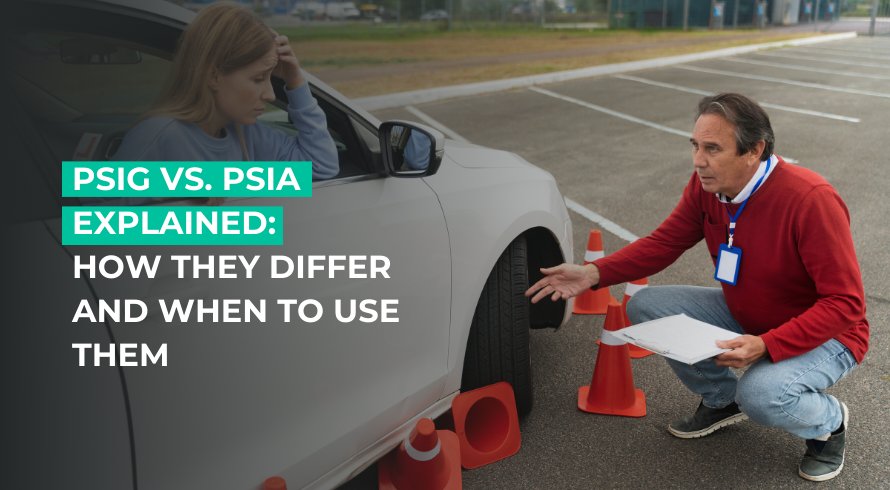As a mechanic, you’ve probably noticed that tire pressure readings can change. It all depends on whether you’re at sea level or in the mountains. You need to understand the difference between PSIA vs PSIG. This will help you avoid costly mistakes and keep your customers’ vehicles safe.
Pressure measurements can seem straightforward. But, understanding the difference between them makes a lot of difference when inflating tires. Let’s break down the essentials of PSI, PSIA, and PSIG. This will help you understand how these measurements affect everything from tire inflation to complex systems like air suspension. Using the wrong measurement could cause serious safety risks in your auto shop.
What’s the difference between PSI, PSIA, and PSIG?
PSI
This is the most common unit of pressure measurement in the United States. It stands for Pounds per Square Inch. From basketballs to vehicle tires, PSI is used to measure pressure. But we have to specify whether it is absolute or gauge.
PSIA
This measurement considers atmospheric pressure. It stands for Pounds per Square Inch Absolute. It represents the total pressure exerted. And it includes the pressure from the atmosphere.
Atmospheric pressure at sea level is 14.7 PSI. That means if you’re getting a reading of 30 PSIA, the pressure inside the tire is 15.3 PSI higher than the air pressure outside.
PSIG
This measurement reflects pressure relative to atmospheric pressure. It stands for Pounds per Square Inch Gauge. It tells us how much pressure is above atmospheric pressure. A reading of 30 PSIG means the pressure is 30 PSI higher than the current atmospheric pressure.
The key difference is whether atmospheric pressure is included or excluded. PSIA includes it, and PSIG does not.
Understanding tire pressure measurements
How tire pressure is measured
Tire pressure is measured in PSIG. This is because it relates directly to the pressure inside the tire compared to atmospheric pressure. Since the vehicle’s performance and safety depend on optimal tire pressure, PSIG is used.
Why? We’re explaining it all below.
Use of PSIG in tire pressures
When checking tire pressure, drivers use PSIG gauges. For instance, if a tire gauge reads 32 PSIG. This will mean that the tire pressure is 32 PSI above atmospheric pressure. The atmospheric pressure can vary with altitude and weather conditions. Hence, using PSIG means that the measurement is relevant to real-world conditions.
Safety implications of using the wrong measurement
Using the incorrect tire pressure measurement can lead to various safety risks for your customer.
Under-inflated tires
When tires are under-inflated (not enough air pressure) it can cause excessive heat buildup. This increases the chance of blowouts because of the friction and heat. Which means accidents on the road.
Over-inflated tires
Tires with too much pressure reduce the amount of rubber contacting the road. With this, there is less traction. Plus there is poorer handling and increased braking distance. This makes them prone to damage from road hazards.
Conversion from PSIG to PSIA
You can easily convert PSIG to PSIA, and vice versa. All you need is the atmospheric pressure.
To convert PSIG to PSIA, you can use the formula:
PSIG = PSIA – Atmospheric Pressure (14.7 PSI at sea level)
And conversely
PSIA=PSIG+Atmospheric Pressure (14.7 PSI at sea level)
For example, if a tire measures 30 PSIG, the conversion will be: PSIA=30+14.7=44.7
Tools and resources for easy conversion
There are many online calculators and mobile apps that can assist in converting pressure measurements. This helps in accuracy in applications that require precise measurements.
Effects of altitude and temperature on air pressure measurements
Altitude impact
Altitude significantly affects pressure measurements. As you ascend, atmospheric pressure decreases. This can alter gauge pressure readings. For instance, at a higher elevation, a tire might show a lower PSIG reading. This is even if the actual pressure remains unchanged. This can mislead you and your team when diagnosing tire pressure issues, especially in high-altitude regions.
Temperature influence
Temperature also affects air pressure readings. For example, cold weather can reduce tire pressure. When this happens, drivers have to make adjustments to maintain optimal performance. It’s advisable for drivers to check their tire pressures regularly, particularly in extreme temperatures. This helps maintain safety and efficiency.
Why the difference between PSIA and PSIG matters for auto shops
When you’re working on cars, you need to be as accurate as possible. Especially with systems that rely on precise pressure measurements. These include the likes of engines, brakes, and suspension. Using the correct pressure measurement—PSIA (which includes atmospheric pressure) or PSIG (which doesn’t)—can make a huge difference in how these systems perform and how safe they are.
For example, if you’re working on vacuum-powered brake boosters or turbocharged engines, PSIA is important because it factors in atmospheric pressure, which changes with altitude. If you don’t account for that, the system might not work as expected, leading to performance problems or even safety risks.
In real-world scenarios, misusing these measurements can have serious consequences. In a hydraulic braking system, using PSIG instead of PSIA could underestimate the actual pressure. This could result in weaker braking force and longer stopping distances. And this inevitably leads to potential brake failure.
For mechanics, understanding the difference between PSIA and PSIG is necessary. It ensures your repairs and maintenance keep vehicles running safely and reliably on the road.
Pressure measurement best practices
How to measure tire pressure accurately
To ensure accurate pressure readings, check tire pressure when the tires are cold and before driving. Adjust for altitude if necessary. Especially in mountainous regions.
Importance of regular calibration
Regular calibration of pressure gauges helps maintain accuracy. Gauges can drift over time. This leads to incorrect pressure readings. This can have significant safety implications.
Common misconceptions about PSI, PSIA, and PSIG
Understanding absolute zero pressure
A common misconception is misunderstanding absolute zero pressure. PSIA starts at zero pressure in a vacuum. While PSIG can show negative values. This represents pressure below atmospheric levels.
PSIG and atmospheric pressure confusion
Another frequent error involves confusing PSIG with atmospheric pressure. PSIG gauges indicate pressure above atmospheric levels. And PSIA includes atmospheric pressure. This can lead to potential miscalculations in various applications.
Wrapping up
When it comes to cars, getting the pressure right is more than just a number. It is about keeping your customer’s vehicle safe and performing at its best. Whether you’re simply checking tire pressure or working on more complex systems like your engine or brakes. Get a good understanding of the difference between PSI, PSIA, and PSIG.
Mastering these pressure measurements will help you fine-tune performance, prevent accidents, and keep your customers’ vehicles running safely and smoothly. The next time you’re inflating tires or working on a brake system, remember—getting the pressure right isn’t just about numbers. It’s about safety, efficiency, and giving your customers a reliable, safe ride.
FAQs
How do I convert PSIG to PSI?
Convert PSIG to PSI by adding atmospheric pressure (typically 14.7 PSI at sea level) to the PSIG value.
What's the difference between gauge pressure and absolute pressure?
Gauge pressure (PSIG) measures pressure relative to atmospheric pressure, while absolute pressure (PSIA) includes atmospheric pressure.









